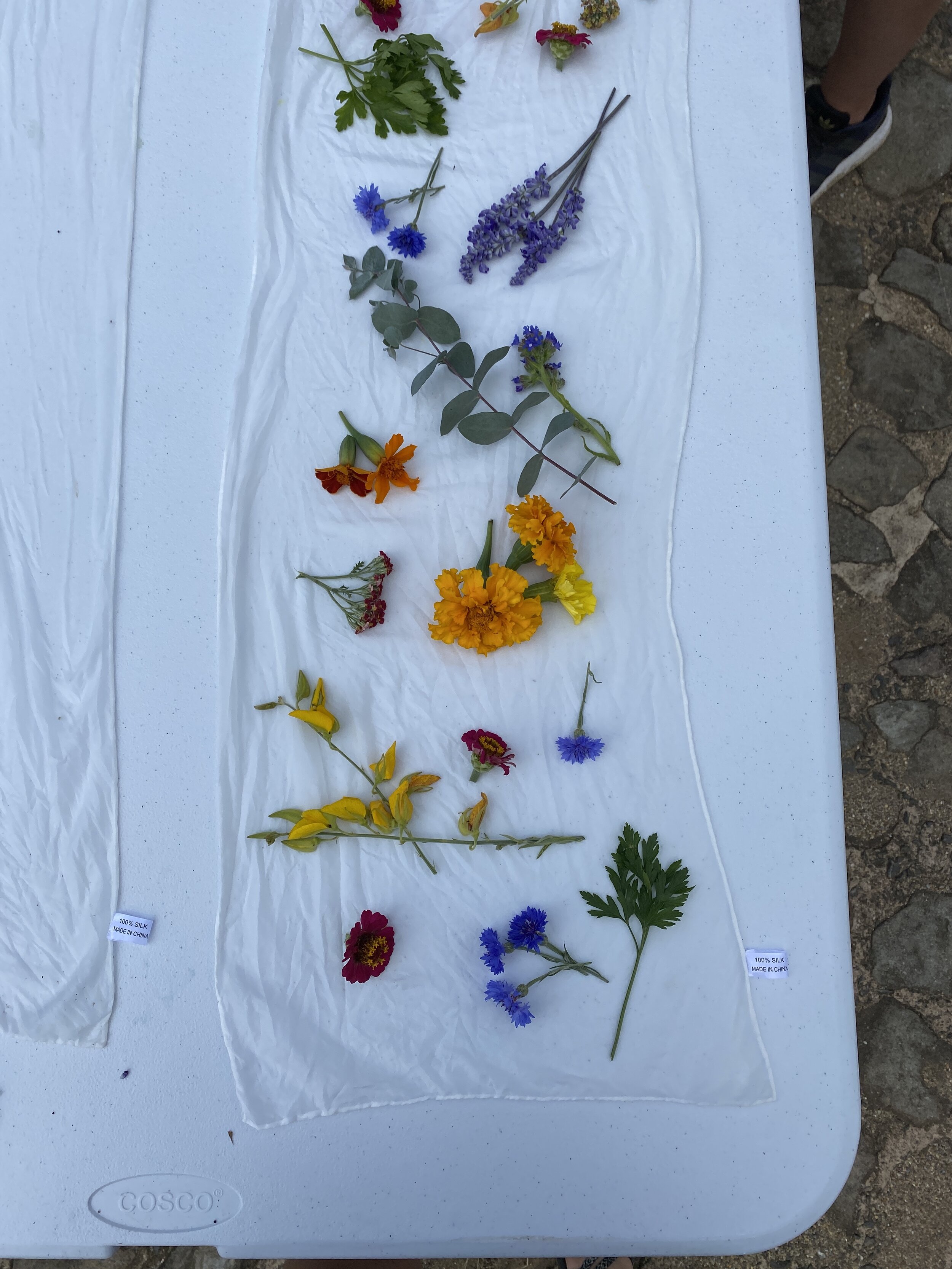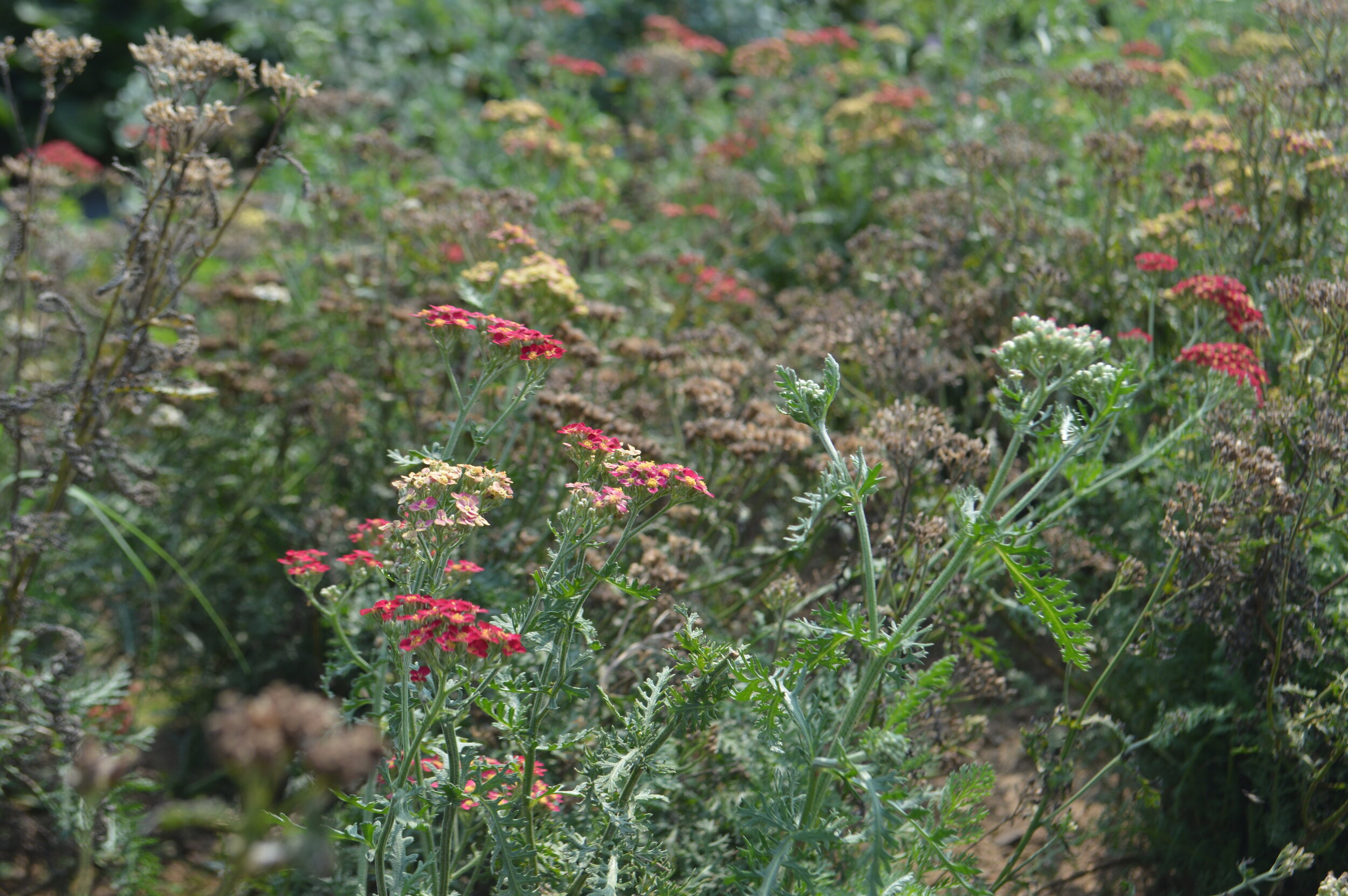Grow the Rainbow: Five Easy Plants for your Natural Dye Garden
Emily Ellis
One of the star attractions of several of our short courses and workshops this year has been the dye garden at the Biocultural Conservation Farm. These fascinating plants are nestled in the walled garden, a space that is divided into sections for some of the farm’s most interesting, useful and beautiful plants, including plots for fiber plants, medicinal plants, and seed-saving.
Photo by Caitlin Etherton, from our recent natural dye workshop
While we all know that pigment-rich plants like Japanese indigo and woad (which were featured in our recent Natural Dye workshop!) make tried and true dyes, many other plants - some of which you likely add to your salad or knock down with the weed eater - can produce stunning and surprising colors. Several of our recent artists in residence have also created beautiful works using dye plants from the garden.
Not only is natural dyeing a lot of fun, it’s better for the environment - natural dyes are biodegradable, don’t need to be mixed with harsh chemicals, and use far less water than synthetic dyes. Often, the only extras you need for natural dyeing are mordants or fixatives to help the color adhere to the fabric, which are typically common kitchen items such as alum powder, salt, or cream of tartar.
Interested in trying your hand at some natural dyeing? Fiber artist Rosa Chang, the leader of our recent Natural Dye Workshop course, has some great information and inspiration for natural dye projects on her website. If you’re looking to add some interesting and multi-use dye plants to your own garden, scroll down to read about five hardy, easy-growing plants from the BCCF’s dye garden that produce surprising and vibrant colors.
Yarrow
Lovely, lacy yarrow is a native perennial that has grown in wild and cultivated spaces at Oak Spring for many decades. In fact, it used to grow in the walled garden as a cut flower during Mrs. Mellon’s time! Although often described as weed, it has a storied history both as a dye plant and as a medicinal herb: besides its well-earned reputation as a slower of bleeding (it’s also known as the nosebleed plant), yarrow has been used to aid digestion, treat anxiety, and treat skin complaints such as hemorrhoids - likely due to its anti-inflammatory properties.
You wouldn’t necessarily know by looking at it, but its leaves, flowers and stems also create a beautiful yellow dye. Yarrow posses dye compounds that include quercetin, luteolin, isorhamnetin, which are found in many plants that are used for natural dyes. The varieties we grow in the dye garden include common yarrow, paprika, parker's gold, and terracotta (another homage to Mrs. Mellon and her love of a terracotta pot!)
Tango Cosmos
These bright flowers will add a fire-y hue to your garden as well as your fibers! Cosmos are another hardy, beautiful flower that have grown all over Oak Spring for many years. Although you wouldn’t necessarily think of them as a dye plant, they have been Caitlin Etherton’s (the BCCF’s greenhouse manager, who also planned and planted the dye garden) favorite flower to dye with. The yellow and orange varieties produce colors ranging from golden yellow, to olive green, to deep, coppery orange, depending on the dyeing process and mordant used. As a bonus, they’re a pollinator favorite and self-seed very well, meaning you’re sure to have a good stock of them every year!
Parsley
If you ever find yourself with an overabundance of parsley and are sick of sticking it in recipes, try dyeing with it - you’ll likely be rewarded with a beautiful yellow-green.
Parsley solar-dyeing a dish cloth.
Like many plants on this list, parsley is much-loved by pollinators, and is a host plant for the black swallowtail caterpillar. It’s also good for humans. You’ve probably heard the nutritional benefits of eating a diet full of richly-colored culinary plants; parsley is one of many vibrant herbs, fruits and vegetables that can also do double-duty as a dye plant.
Spinach, beets, bronze fennel, red rubin basil, pusa asita carrots and black nebula carrots are also growing in the BCCF’s dye garden. The pigments that make these foods so brilliantly colored are also what makes them so good for us; research has shown that pigments protect plants from damage, and that their antioxidant role in human bodies is not dissimilar. So if you wear a shirt dyed with parsley or golden-yellow turmeric, you can picture those health benefits seeping into your skin (this isn’t proven, but it’s fun to imagine!) - or at the very least, as Caitlin says, be reminded to eat more parsley!
Sunflowers
Photo by Caitlin Etherton
One of the richest and most gorgeous natural dyes is that which comes from the seeds of the Hopi Black Dye Sunflower, which range from maroon-red, deep maroon, dark purple, deep lavender, medium blue and black, depending on the dyeing method used. Hopi Black Dye Sunflowers (Tceqa' Qu' Si) have long been cultivated by the Hopi people, used to color cotton, wool, and basketry. Although traditionally grown in irrigated terraces in what is now northern Arizona, they’re a tough, quick-growing, and pest-resistance plant that also does quite well here in the Virginia piedmont (here’s a great blogpost from natural dyer Anna Meier about Hopi Dye Sunflowers, and her experiences growing and dyeing with them).
Hopi Dye Sunflowers are far and away the best variety for dyeing, but feel free to experiment with the seeds and petals of other sunflowers too! Richly colored ‘Autumn Beauty’ sunflowers (a favorite of Bunny Mellon) also produce interesting natural dyes.
Marigolds
Dutch School, An Album of Garden Flowers and manuscript Book Detailing Plant Purchases, circa 1680.
Is there anything marigolds can’t do? They’re edible, repel garden pests, grow easily under a wide variety of conditions, and produce stunning natural dyes ranging from yellow to orange (or try mixing them with indigo for a gorgeous teal shade!) Native to Central America, marigolds are now found worldwide, where they are used both as both a dye and for spiritual and ceremonial purposes, due in part to their vibrant color. In Mexico, the use of cempasuchil (an indigenous Nahuatl word from central Mexico meaning “twenty petals”) in ceremonies to commemorate the dead dates back to Aztec feast days. In present-day Día de los Muertos ceremonies, the flowers’ resemblance to the sun and strong, sweet scent helps guide spirits back to earth for the festivities. In Hindu culture, the flowers - called genda phool - adorn altars and wedding guests, as well as bodies at funerals.
If you’re looking for more hardy and multi-use plants to add to your natural dye garden, yarrow, asters, Hopi Red Dye amaranth, dyer’s chamomile, and eucalyptus are other fun additions! And if you’re curious to know whether a plant can be used for natural dye, look at its Latin name - “tinctoria" often indicates that there is a pigment or dye in it!
Thanks to BCCF greenhouse manager Caitlin Etherton for her help with this blogpost!
Banner image by Christine Harris







